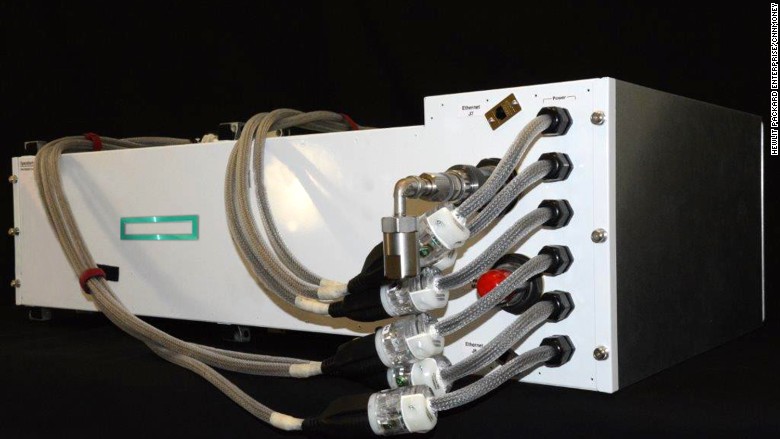Developing A Supercomputer In Space: China's Progress And Future Plans

Table of Contents
The Challenges of Building a Space-Based Supercomputer
Creating a supercomputer capable of operating in the harsh environment of space presents formidable challenges. These challenges require innovative solutions across multiple engineering disciplines.
Harsh Space Environment
The space environment is exceptionally hostile to electronic equipment. Several factors significantly impact the design and functionality of a space-based supercomputer:
- Extreme temperature fluctuations: Space experiences drastic temperature swings, ranging from the intense heat of direct sunlight to the frigid cold of deep shadow. Components must withstand these extremes without malfunction.
- Radiation exposure and its effects on components: High-energy radiation, including cosmic rays and solar flares, can damage electronic components, leading to bit flips and system errors. Radiation hardening is crucial.
- Micrometeoroid and orbital debris impacts: Collisions with even tiny particles can cause significant damage. Redundancy and protective shielding are essential design considerations.
- Vacuum of space and its impact on cooling systems: The vacuum of space complicates heat dissipation. Traditional cooling methods are ineffective, necessitating innovative approaches like passive radiative cooling or advanced liquid cooling systems.
Miniaturization and Power Constraints
Building a powerful supercomputer for space demands significant miniaturization while maintaining high performance. Power is another critical constraint:
- Need for high-performance computing in a compact form factor: The space-based supercomputer must pack immense computational power into a minimal volume to reduce weight and size.
- Limited power availability in space; efficient power management is critical: Power generation in space is limited, requiring highly efficient power management systems and low-power components.
- Challenges in heat dissipation in a confined environment: Efficient heat removal is vital to prevent overheating, especially in a confined space with limited cooling options.
- Development of radiation-hardened components: Components must be designed to withstand the damaging effects of space radiation, requiring specialized materials and manufacturing techniques.
China's Current Progress in Space-Based Computing
Despite these challenges, China has made significant strides in developing the technology necessary for a space-based supercomputer.
Technological Advancements
China's investment in research and development has yielded considerable progress in key areas:
- Development of specialized, radiation-resistant processors and memory: Researchers are developing custom processors and memory chips designed to withstand the harsh radiation environment of space.
- Research into advanced cooling systems for space applications: Innovative cooling technologies are being developed to address the unique challenges of heat dissipation in space. This includes exploring advanced liquid cooling and passive radiative cooling techniques.
- Progress in miniaturizing high-performance computing components: Advances in microelectronics are enabling the creation of increasingly powerful and compact computing components suitable for space applications.
- Investment in high-bandwidth space-based communication networks: High-speed data transmission is essential for a space-based supercomputer. China is investing heavily in developing robust space-based communication networks.
Successful Missions and Demonstrations
While a fully operational space-based supercomputer is still under development, China has undertaken several missions demonstrating related technologies: (Specific mission examples and details should be inserted here based on publicly available information. Include links to relevant research papers or official statements). These missions have provided valuable data on the performance and reliability of space-based computing systems in real-world conditions.
Future Plans and Applications of China's Space Supercomputer
China's plans for a space-based supercomputer extend far beyond current capabilities, promising a revolution in various applications.
Expanding Capabilities
Future developments aim to significantly enhance the power and functionality of space-based computing:
- Plans for increased computing power and data storage capacity: Future iterations will boast significantly increased processing power and data storage capacity, enabling more complex computations and data analysis.
- Development of more sophisticated algorithms and software for space-based processing: Specialized algorithms and software optimized for space-based environments will be developed to maximize efficiency and performance.
- Integration with other space-based technologies like Earth observation satellites: The space-based supercomputer will be integrated with other space assets, creating a synergistic system for data acquisition and analysis.
- Potential for artificial intelligence (AI) and machine learning in space: The incorporation of AI and machine learning will enable autonomous data processing and analysis, leading to enhanced capabilities.
Potential Applications
The applications of a fully functional space-based supercomputer are vast and transformative:
- Advanced Earth observation and climate modeling: High-resolution Earth observation data processed by the supercomputer will improve climate modeling and environmental monitoring.
- Real-time monitoring and analysis of natural disasters: Rapid analysis of disaster data will enable quicker and more effective response efforts.
- Deep space exploration and astronomical research: The supercomputer will facilitate complex astronomical research and enhance the capabilities of deep-space missions.
- Improved satellite communication and navigation systems: Space-based computing will improve the accuracy and reliability of satellite communication and navigation systems.
- Development of new materials and technologies in microgravity: Experiments conducted in space and processed by the supercomputer will accelerate the development of new materials and technologies.
Conclusion
China's pursuit of a space-based supercomputer represents a bold leap forward in space technology. Overcoming the immense challenges associated with building and operating such a system requires significant advancements in various fields, from materials science and electronics to software engineering and communication technologies. While considerable progress has already been made, the future potential of this technology is vast, promising to transform scientific research, enhance global monitoring capabilities, and propel further exploration of the cosmos. Continued investment and international collaboration in the development of space-based supercomputers will be crucial to unlocking the full potential of this revolutionary technology. Stay informed about China's ongoing progress in this exciting field of space-based supercomputing and witness the future of space exploration unfold.

Featured Posts
-
 Australia Conquered Man Sets New Fastest Foot Crossing Time
May 21, 2025
Australia Conquered Man Sets New Fastest Foot Crossing Time
May 21, 2025 -
 Real Madrid In Ancelotti Sonrasi Planlari Klopp Ve Diger Adaylar
May 21, 2025
Real Madrid In Ancelotti Sonrasi Planlari Klopp Ve Diger Adaylar
May 21, 2025 -
 A Step By Step Plan For A Screen Free Week With Your Children
May 21, 2025
A Step By Step Plan For A Screen Free Week With Your Children
May 21, 2025 -
 No Es El Arandano Descubre El Superalimento Para Un Envejecimiento Saludable
May 21, 2025
No Es El Arandano Descubre El Superalimento Para Un Envejecimiento Saludable
May 21, 2025 -
 Big Bear Ai Bbai Stock Plummets Missed Revenue And Leadership Changes
May 21, 2025
Big Bear Ai Bbai Stock Plummets Missed Revenue And Leadership Changes
May 21, 2025
Latest Posts
-
 Huuhkajat Avauskokoonpanoon Kolme Muutosta Kaellman Penkille
May 21, 2025
Huuhkajat Avauskokoonpanoon Kolme Muutosta Kaellman Penkille
May 21, 2025 -
 Benjamin Kaellman Kasvua Ja Maaleja Huuhkajien Riveissae
May 21, 2025
Benjamin Kaellman Kasvua Ja Maaleja Huuhkajien Riveissae
May 21, 2025 -
 Kaellmanin Ja Hoskosen Puola Ura Paeaettymaessae
May 21, 2025
Kaellmanin Ja Hoskosen Puola Ura Paeaettymaessae
May 21, 2025 -
 Huuhkajat Kaksikko Kaellman Ja Hoskonen Laehtevaet Puolasta
May 21, 2025
Huuhkajat Kaksikko Kaellman Ja Hoskonen Laehtevaet Puolasta
May 21, 2025 -
 Kaellman Ja Hoskonen Loppu Puolan Seuralle
May 21, 2025
Kaellman Ja Hoskonen Loppu Puolan Seuralle
May 21, 2025
